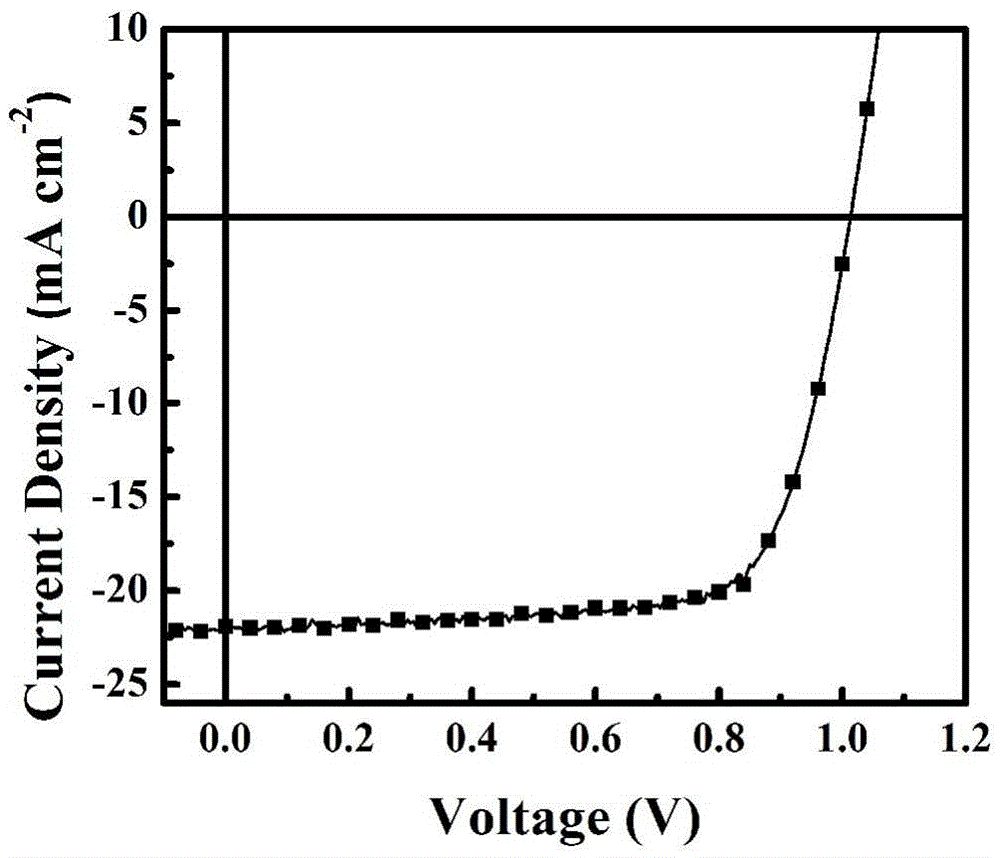Novel hole transport layer material and perovskite solar cell composed by novel hole transport layer material
A technology of hole transport layer and solar cell, which is applied in the direction of circuits, photovoltaic power generation, electrical components, etc., and can solve the problems of easily damaged perovskite layer, unfavorable stability of battery devices, and low hole mobility
- Summary
- Abstract
- Description
- Claims
- Application Information
AI Technical Summary
Problems solved by technology
Method used
Image
Examples
Embodiment 1
[0038] Using 3,8,13-tribromo-5,5,10,10,15,15-hexa-n-hexyl-10,15-dihydro-5-hydro-indene [1,2-α; 1',2 '-c] fluorene (Trux-Br 3 ) with the Buchwald-Hartwig coupling reaction of two (4-methoxyphenyl) amine (OMeDPA) to synthesize Trux-OMeTAD, and the reaction equation is:
[0039]
[0040] Among them, Trux-Br 3 Synthesized by the method reported in the literature Macromolecules2004, 37, 8874-8882, OMeDPA can be purchased through commercial channels. The synthetic steps of Trux-OMeTAD are:
[0041] Add 0.500g Truxene-Br to the dry reaction vial 3 , 0.400gOMeDPA, and 0.450g sodium tert-butoxide, then add 10mL toluene, build a closed reaction reflux device, freeze the mixed solution with liquid nitrogen, and then carry out three cycles of vacuuming and filling nitrogen, under the protection of nitrogen, add 10mgPd 2 (dba) 3 As a catalyst, 0.02 mL of tri-tert-butylphosphine toluene solution (1.0 M) was used as a ligand, followed by three cycles of evacuation and nitrogen filling,...
Embodiment 2
[0044] Using 3,8,13-tribromo-5,5,10,10,15,15-hexa-n-hexyl-10,15-dihydro-5-hydro-indene [1,2-α; 1',2 '-c] fluorene (Trux-Br 3 ) with the Buchwald-Hartwig coupling reaction of two (5-methoxythienyl) amines (OMeDTA) to synthesize Trux-OMeTADT, and the reaction equation is:
[0045]
[0046] Add 0.500g Truxene-Br to the dry reaction vial 3 , 0.440gOMeDTA, and 0.450g sodium tert-butoxide, then add 10mL toluene, build a closed reaction reflux device, freeze the mixed solution with liquid nitrogen, and then carry out three cycles of vacuuming and filling nitrogen, under the protection of nitrogen, add 10mgPd 2 (dba) 3 As a catalyst, 0.02 mL of tri-tert-butylphosphine toluene solution (1.0 M) was used as a ligand, followed by three cycles of evacuation and nitrogen filling, followed by thawing and heating to reflux at 110° C. for 10 hours. After the reaction, the reaction solution was extracted with dichloromethane, washed three times with concentrated brine, the organic phase w...
Embodiment 3
[0049] Using 3,8,13-tribromo-5,5,10,10,15,15-hexa-n-hexyl-10,15-dihydro-5-hydro-indene [1,2-α; 1',2 '-c] fluorene (Trux-Br 3 ) and the Buchwald-Hartwig coupling reaction of two (4-methylthiophenyl) amine (SMeDPA) to synthesize Trux-SMeTAD, the reaction equation is:
[0050]
[0051] Add 0.500g Truxene-Br to the dry reaction vial 3 , 0.420g SMeDPA, and 0.450g sodium tert-butoxide, then add 10mL toluene, build a closed reaction reflux device, freeze the mixed solution with liquid nitrogen, and then carry out three cycles of vacuuming and filling nitrogen, under the protection of nitrogen, add 10mgPd 2 (dba) 3 As a catalyst, 0.02 mL of tri-tert-butylphosphine toluene solution (1.0 M) was used as a ligand, followed by three cycles of evacuation and nitrogen filling, followed by thawing and heating to reflux at 110° C. for 10 hours. After the reaction, the reaction solution was extracted with dichloromethane, washed three times with concentrated brine, the organic phase was c...
PUM
 Login to View More
Login to View More Abstract
Description
Claims
Application Information
 Login to View More
Login to View More - R&D
- Intellectual Property
- Life Sciences
- Materials
- Tech Scout
- Unparalleled Data Quality
- Higher Quality Content
- 60% Fewer Hallucinations
Browse by: Latest US Patents, China's latest patents, Technical Efficacy Thesaurus, Application Domain, Technology Topic, Popular Technical Reports.
© 2025 PatSnap. All rights reserved.Legal|Privacy policy|Modern Slavery Act Transparency Statement|Sitemap|About US| Contact US: help@patsnap.com



